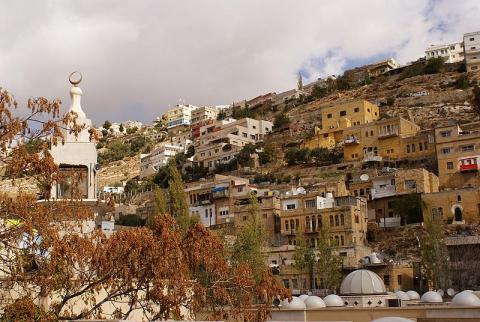
JORDAN’S NORTHERN ATTRACTIONS
The rolling hills of northern Jordan hold some of the loveliest countryside in the whole Middle East, with acres of olive and fig trees, patches of ancient pine forest and fields of wheat interspersed with fertile, cultivated valleys that point the way west down to the deep Jordan Valley. This is the most densely populated part of the country, and every hill and wadi has its village. Many of the local people are from ancient Syrian or Transjordanian families, but plenty of towns also have a significant population of Palestinians, who continue to farm the East Bank of the Jordan much as they did the West Bank and Galilee before having to flee in the wars of 1948 and 1967.
JERASH

The best example of a Roman provincial city in the whole Middle East with its amazing blend of Greco-Roman and Oriental influences. The ruined city of Jerash covers a huge area imposing ceremonial gates, colonnaded avenues, temples and theatres all speak to the time when this was an important imperial center. Recent excavations showed that Jerash was already inhabited during the Bronze Age, so its heydays had been in the 2nd century with a population of minimum 20,000. The Roman Emperor Trajan constructed roads throughout the provinces, more trade came to Jerash and the town prospered. To honor the visit of Emperor Hadrian in 130 AD, a triumphal arch was built. The so called Hadrian' Arch is from where visitors start the Jerash tour.
AJLOUN CASTLE

Around 70 km distant from Amman, you find in northern Jordan Ajloun Castle, in Arabic called Qal'at Ar-Rabad. It was built by Izz al-Din Usama, one of Salah al-Din's generals in 1184 AD. It had several purposes, to control the iron mines of Ajloun, and to protect the country from Crusader attacks. The castle dominated the three main routes leading to the Jordan Valley and protected the trade and commercial routes between Jordan and Syria; it became an important link in the defensive chain against the Crusaders. The original castle had four towers; arrow slits incorporated into the thick walls and it was surrounded by a moat averaging 16 meters in width and up to 15 meters in depth. In 1215 AD, the Mameluk officer Aibak ibn Abdullah expanded the castle, by adding a new tower in the southeast corner and a bridge that can still be seen decorated with pigeon reliefs.
UMM QAIS

This historic castle was built atop Mt ‘Auf (1250m) between 1184 and 1188 by one of Saladin’s generals, ‘Izz ad Din Usama bin Munqidh (who was also Saladin’s nephew). The castle commands views of the Jordan Valley and three wadis leading into it, making it an important strategic link in the defensive chain against the Crusaders and a counterpoint to the Crusader Belvoir Fort on the Sea of Galilee in present-day Israel and the Palestinian Territories.Umm Qais, situated 110 km (68 miles) north of Amman on a broad promontory 378 meters above sea level with a magnificent view over the Yarmouk River, the Golan Heights, and Lake Tiberias, this town was known as Gadara, one of the most brilliant ancient Greco-Roman cities of the Decapolis; and according to the Bible, the spot where Jesus (pbuh) cast out the Devil from two demoniacs (mad men) into a herd of pigs (Mathew 8:28-34).
SALT CITY

Salt, just a half hour drive from Amman, is an ancient agricultural town and administrative center. The town was known as Saltus in Byzantine times and seat of a bishopric. The settlement was destroyed by the Mongols, then rebuilt during the reign of the Mamluk sultan Baybars I (1260-1277) and became a regional capital once more during the time of the Ottoman Empire. The architecture of this period is the highlight, houses with long-arched windows in picturesque narrow streets.
PELLA

Pella is located in the Jordan Valley and in nice surroundings visitors see ancient ruins from Roman and Byzantine period. Pella was like the city of Gadara a member of the Decapolis, a union of cities in Palestine, Jordan and southern Syria which were centres of Greco-Roman culture. Known in Arabic as Tabaqat Fahl, Pella has been continuously occupied for 6000 years from the Neolithic to the Byzantine and early Islamic periods (5000 BC- circa 800 AD). Like Jerash and Umm Quais it prospered during the Greco-Roman period from the links to trade routes and different cultural influences. After the Roman conquest Pella became a member of the Decapolis, the conferderation of ten cities linked by commercial and political interests.